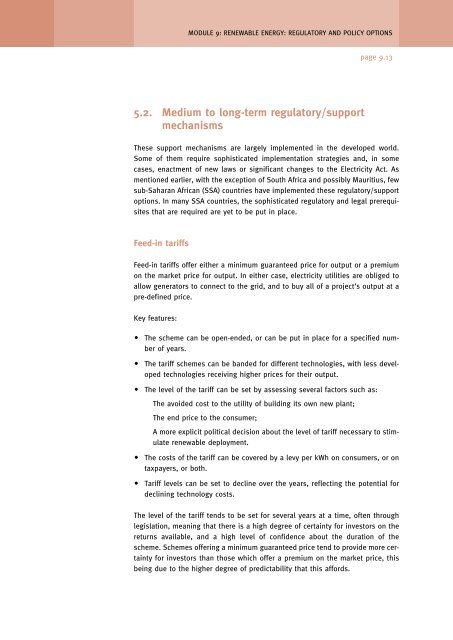Regulatory and policy options to encourage development of ...
Regulatory and policy options to encourage development of ...
Regulatory and policy options to encourage development of ...
- No tags were found...
Create successful ePaper yourself
Turn your PDF publications into a flip-book with our unique Google optimized e-Paper software.
MODULE 9: RENEWABLE ENERGY: REGULATORY AND POLICY OPTIONSpage 9.135.2. Medium <strong>to</strong> long-term regula<strong>to</strong>ry/supportmechanismsThese support mechanisms are largely implemented in the developed world.Some <strong>of</strong> them require sophisticated implementation strategies <strong>and</strong>, in somecases, enactment <strong>of</strong> new laws or significant changes <strong>to</strong> the Electricity Act. Asmentioned earlier, with the exception <strong>of</strong> South Africa <strong>and</strong> possibly Mauritius, fewsub-Saharan African (SSA) countries have implemented these regula<strong>to</strong>ry/support<strong>options</strong>. In many SSA countries, the sophisticated regula<strong>to</strong>ry <strong>and</strong> legal prerequisitesthat are required are yet <strong>to</strong> be put in place.Feed-in tariffsFeed-in tariffs <strong>of</strong>fer either a minimum guaranteed price for output or a premiumon the market price for output. In either case, electricity utilities are obliged <strong>to</strong>allow genera<strong>to</strong>rs <strong>to</strong> connect <strong>to</strong> the grid, <strong>and</strong> <strong>to</strong> buy all <strong>of</strong> a project’s output at apre-defined price.Key features: The scheme can be open-ended, or can be put in place for a specified number<strong>of</strong> years. The tariff schemes can be b<strong>and</strong>ed for different technologies, with less developedtechnologies receiving higher prices for their output. The level <strong>of</strong> the tariff can be set by assessing several fac<strong>to</strong>rs such as:The avoided cost <strong>to</strong> the utility <strong>of</strong> building its own new plant;The end price <strong>to</strong> the consumer;A more explicit political decision about the level <strong>of</strong> tariff necessary <strong>to</strong> stimulaterenewable deployment. The costs <strong>of</strong> the tariff can be covered by a levy per kWh on consumers, or ontaxpayers, or both. Tariff levels can be set <strong>to</strong> decline over the years, reflecting the potential fordeclining technology costs.The level <strong>of</strong> the tariff tends <strong>to</strong> be set for several years at a time, <strong>of</strong>ten throughlegislation, meaning that there is a high degree <strong>of</strong> certainty for inves<strong>to</strong>rs on thereturns available, <strong>and</strong> a high level <strong>of</strong> confidence about the duration <strong>of</strong> thescheme. Schemes <strong>of</strong>fering a minimum guaranteed price tend <strong>to</strong> provide more certaintyfor inves<strong>to</strong>rs than those which <strong>of</strong>fer a premium on the market price, thisbeing due <strong>to</strong> the higher degree <strong>of</strong> predictability that this affords.










